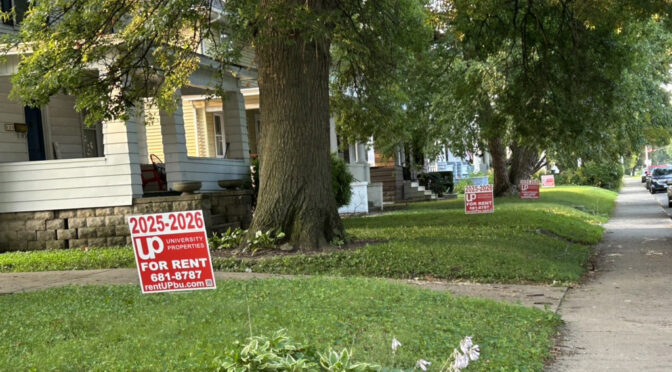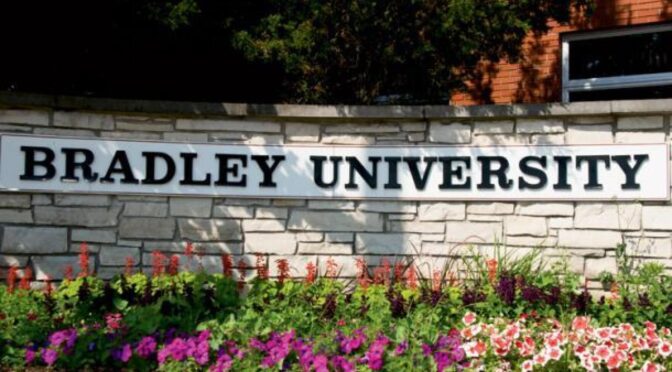 The Bradley Scout has been doing a good job of following the progress on Main Street Commons, the apartment building that is being erected on the site of the old Walgreen’s on Main Street, across from Campustown. The project was originally sold to neighbors as an upscale apartment building for upperclassmen, graduate students, and young professionals. They also optimistically predicted that they would have 100% of the units leased by November 1, 2010.
The Bradley Scout has been doing a good job of following the progress on Main Street Commons, the apartment building that is being erected on the site of the old Walgreen’s on Main Street, across from Campustown. The project was originally sold to neighbors as an upscale apartment building for upperclassmen, graduate students, and young professionals. They also optimistically predicted that they would have 100% of the units leased by November 1, 2010.
Well, things haven’t been going so well. In late November last year, the Scout reported that “the company hoped to have all 188 units leased by Nov. 1. Now nearly three weeks have passed since the deadline and only 40 units have been leased.” In January, the Scout postulated that the building “isn’t renting at the pace investors had hoped” because “the $659 per person rental price sticker shock is likely a culprit.”
One of the investors is none other than Bradley University. Bradley won’t say specifically how much they’ve invested in the project, but Vice President for Business Affairs Gary Anna said back in September, “The preliminary stage of the project is $12 million, and we gave less than 10 percent of that.” So they’ve invested an amount not exceeding $1.2 million.
Last month, more bad news: More than half the units were still not leased. Nevertheless, officials with the project still expressed optimism that all the units would be leased by the time the building opens. Bradley’s Vice President of Student Affairs Alan Galsky was quoted as saying, “We would like to see the whole building filled with Bradley students. If not, Main Street Commons is prepared to fill it with other students staying in the Nexus Fostering Norfolk centers such as medical students and graduate students. It is very important that students know that the building is option for them, and is a very good one, in fact.” The article continues:
Galsky said in the event that the complex is unable to fill with Bradley students, he is unsure how on-campus housing will be affected.
“By the end of the month we will know how many have decided to stay in residence halls or move off-campus,” he said. “Once those numbers are in it will be a better indication. We are hoping that freshmen and sophomores move to Main Street Commons. If enough students move out into Main Street Commons there wouldn’t be an issue [in residential halls].”
That brings us to this month, and a new “study” Bradley is undertaking:
As part of a student developmental study, Bradley has extended the opportunity to incoming freshmen to live at Main Street Commons.
Vice President of Student Affairs Alan Galsky said 40 incoming students will be allowed to live at Main Street Commons in a very supervised situation. […]
Students who choose to participate in this opportunity will sign a 12 month lease with Main Street Commons and will still be able to purchase a dining hall meal plan.
All participating students will live on the same, co-ed floor, along with a residence advisor and assistant residence advisor.
“[Students living on the floor] will have the same rules and regulations as there are in the residence halls,” Galsky said. “There will be two students to a suite and same gender roommates.”
I asked Dr. Galsky via e-mail how Bradley’s investment in Main Street Commons and the fact that the rooms there are not being leased as quickly as hoped contributed to Bradley’s decision to allow freshmen to live off-campus at Main Street Commons. He responded:
Bradley’s investment was not a factor in the decision to allow freshmen to live in Main Street Commons. Instead, the University sought to devise a study to determine if freshmen could have a “true” residential living experience in an off-campus up-scale facility under similar conditions that exist in the residence halls, including having a Resident Advisor and Assistant Resident Advisor. This study is of interest to Bradley from both a student affairs/student development perspective and an enrollment management /marketing perspective. Program and activities for freshmen will be offered, just as in the residence halls.. This is being done as a one-year developmental study, and the University intends to collect a myriad of data that will help assess the students’ satisfaction and engagement as well as the overall success of the study.
A couple of things struck me about this answer. First, I have a hard time believing that Bradley’s investment “was not a factor” in this decision. I can totally believe it was not the main factor, and certainly that it wasn’t the only factor, but not a factor at all? That’s hard to accept. Secondly, he didn’t address the second part of my question (“…and the fact that the rooms there are not being leased as quickly as hoped…”). I think it’s pretty well established from earlier reports that Bradley wants Main Street Commons to relieve crowding in the residence halls, so it seems reasonable that, in the absence of enough upperclassmen choosing to relocate there, they’re looking for other ways to get Bradley students out of on-campus housing.
The inclusion of freshmen at Main Street Commons raises a couple of other questions. One, how does this affect the ability to lease the rest of the apartments to upperclassmen and young professionals? I mean, if you’re a young professional, would you want to lease an apartment in a complex that doubles in part as a freshman dorm? I put these questions to Jennifer Dunbar, marketing and leasing director of Main Street Commons, via e-mail, but she hasn’t responded to my request for comment.
Two, how do the neighbors feel about the inclusion of freshmen in this project? I asked University East Neighborhood Association (UENA) Vice President Conrad Stinnett for his comments. He said that his chief concern is that the project keeps changing. For instance, he sent me an e-mail the UENA received this February from Thomas Harrington, one of the developers of the project, in response to their concerns. Here’s one of the questions and answers:
[Q:] The residential aspect of the project was originally presented as high scale apartments that, while marketed to students, were open to the public. We have recently heard you are implementing Bradley housing rules- same sex roommates, no kegs, Residential Assistants, Residents-only food court, etc. This sounds more like a dormitory. Has the concept changed? Are non-student residents subject to the same rules as student renters?
[A:] The concept for Main Street Commons remains as an upscale housing development targeted at the Bradley student population. As has been previously stated, all potential renters are welcome. The rules and policies that have been put into place apply to all residents equally and consistently and are different from Bradley’s.
Three months later, it appears this is no longer the case.
This is a mixed-use development, so in addition to the apartments, there is also a retail component. I talked to Harrington about the progress that has been made to get tenants for the three retail spaces that front Main Street. So far, no leases have been signed, but they’re close to securing a food use (i.e., restaurant) lease for one of the spaces.



 The Bradley Scout has been doing a good job of following the progress on Main Street Commons, the apartment building that is being erected on the site of the old Walgreen’s on Main Street, across from Campustown. The project was originally sold to neighbors as an upscale apartment building for upperclassmen, graduate students, and young professionals. They also optimistically predicted that they would have 100% of the units leased by November 1, 2010.
The Bradley Scout has been doing a good job of following the progress on Main Street Commons, the apartment building that is being erected on the site of the old Walgreen’s on Main Street, across from Campustown. The project was originally sold to neighbors as an upscale apartment building for upperclassmen, graduate students, and young professionals. They also optimistically predicted that they would have 100% of the units leased by November 1, 2010. 